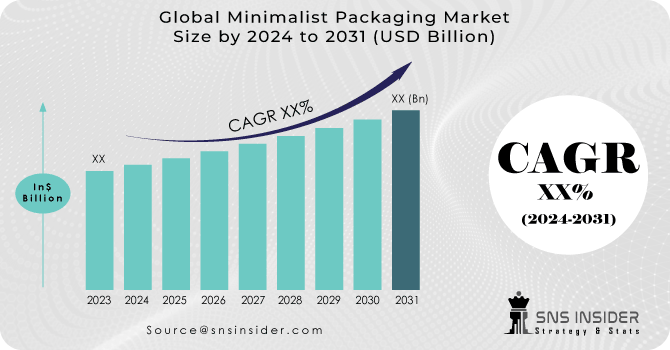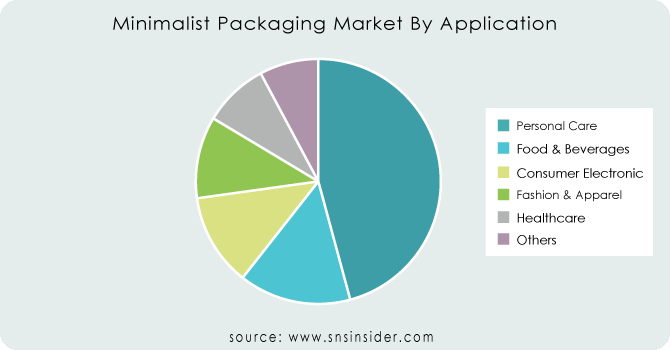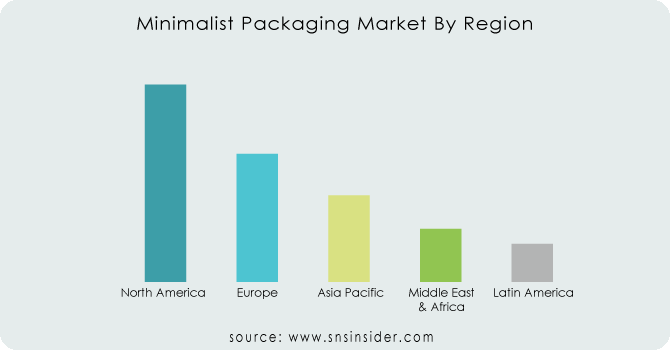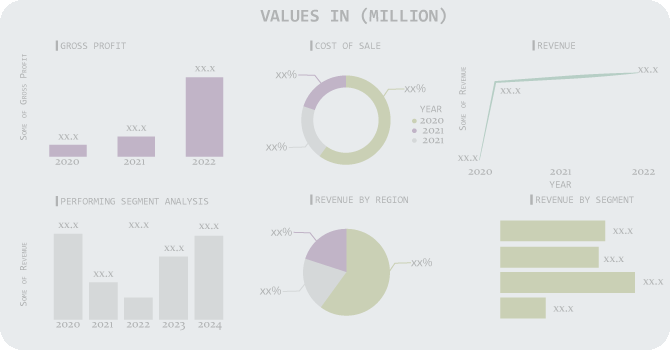In a busy supermarket, products compete for attention with loud packaging that demands notice. Vibrant colors, bold graphics, and large fonts overwhelm shoppers' senses. Amidst this noise, a game-changing presence emerges, a simple box with minimalist packaging. In a world of excess, its simplicity stands out, offering a higher chance of capturing the shopper's gaze. This is the essence of minimalist packaging. Amidst life's chaos, the minimalist movement revolutionizes the packaging industry. Some brands recognize the importance of authentic connections with buyers and opt for understated designs, embracing clean lines, subtle hues, and eco-friendly materials.

Get More Information on Minimalist Packaging Market - Request Sample Report
Minimalist packaging prioritizes functionality and sustainability, utilizing sustainable materials for a clutter-free presentation that appeals to environmentally conscious consumers. It emphasizes product essence and brand identity, aligning with waste reduction and minimalism principles, particularly effective in eco-conscious markets. In essence, it blends form and function, creating visually appealing and purposeful packaging. Minimalist packaging reflects companies' efforts to positively impact the environment, appealing to eco-conscious shoppers. This stands in contrast to wasteful over-packaging practices, which contribute to unnecessary waste and landfills. Choosing minimalist designs or pouches made of biodegradable/recyclable materials offers a sustainable alternative, addressing environmental concerns and promoting responsible consumption.
KEY DRIVERS:
Increasing environmental awareness among consumers has led to a growing demand for sustainable and eco-friendly packaging solutions.
Minimalist packaging design meets this demand by removing unnecessary graphics and messaging, retaining only the essential elements.
Minimalist packaging design eliminates unnecessary graphics and messaging, concentrating solely on the essentials. This approach is adaptable, suitable for industries ranging from luxury goods and cosmetics to food and electronics. Essentially, minimalist packaging design simplifies a brand's identity to its core elements, prioritizing clarity and elegance.
RESTRAIN:
Stringent regulations and industry standards aimed at reducing waste and promoting sustainable practices.
OPPORTUNITY:
Minimalist packaging offers an ideal backdrop for narrating compelling stories and brand messages.
With minimal distractions, brands can effectively communicate their story, values, and product essence. Each element is deliberate, enabling businesses to convey authenticity and forge deeper connections with their target audience. Minimalist packaging serves as a visual storytelling medium, inviting consumers to engage with a brand's narrative and ethos, fostering trust and loyalty.
There is an opportunity to capitalize on consumers' growing interest in sustainable and minimalist packaging.
CHALLENGES:
Finding the equilibrium between simplicity and conveying brand information.
The Russia-Ukraine crisis has significantly impacted the Minimalist Packaging market, causing disruptions in supply chains, shortages of raw materials, and logistical challenges. Key suppliers in Russia and Ukraine are experiencing disruptions, affecting production. Increased transportation costs and delays are also hindering material and product delivery. Cost fluctuations have arisen due to shortages and logistical hurdles, leading to higher prices for packaging materials. Rising energy prices from the conflict add to cost pressures.
The crisis influences consumer behaviour, with some prioritizing minimalist and eco-friendly packaging due to geopolitical stability concerns. Economic uncertainties may reduce discretionary spending, affecting demand in some segments. Companies respond by adapting to supply chain disruptions, exploring alternative materials, and embracing minimalist and sustainable packaging principles. Localization of supply chains is also considered to reduce reliance on geopolitically sensitive regions. In the minimalist packaging market, strategic shifts include broadening supplier bases to manage risks linked to geopolitical conflicts. Companies may also boost investments in sustainable and local sourcing practices to enhance resilience against geopolitical shocks.
Amid economic downturns, brands may prioritize cost-cutting measures, potentially resulting in several outcomes. One such outcome involves companies shifting from minimalist to basic packaging, opting for simpler, less resource-intensive designs to save on immediate costs. Additionally, there may be a reduced emphasis on sustainability, with companies prioritizing short-term financial gains over long-term environmental benefits during periods of economic slowdown. There is expected to be a sustained increase in consumer demand for sustainable and eco-friendly packaging. Additionally, as minimalist packaging becomes increasingly prevalent, the industry may innovate to develop more efficient and cost-effective implementation methods. Government regulations that promote sustainability could offer support for minimalist packaging, even in times of economic downturn. Additionally, in a competitive market, minimalist packaging can serve as a means for brands to distinguish themselves and potentially justify charging higher prices.
By Material
Paper
Plastic
Glass
Metal
Others
By Application
Food & Beverages
Personal Care
Healthcare
Consumer Electronic
Fashion & Apparel
Others

Get Customized Report as per Your Business Requirement - Request For Customized Report
The Minimalist Packaging market is analysed regionally, with North America playing a key role globally. With a significant consumer base and a strong focus on sustainability, the region is influenced by consumer preferences and strict environmental regulations. Europe follows closely, with a large economy and a commitment to sustainable practices, supported by regulatory frameworks promoting circular economy principles. In the Asia Pacific, the market for Minimalist Packaging is gaining traction due to evolving consumer preferences and a thriving manufacturing sector. The regions diverse markets present opportunities for innovation and the adoption of minimalist principles.
Latin America experiences a moderate impact on the Minimalist Packaging market, influenced by economic structures and awareness levels regarding minimalist packaging. The localization of supply chains helps mitigate potential disruptions. In the Middle East & Africa regions, the impact is relatively lower, influenced by distinct economic structures and awareness levels. It's essential for stakeholders to grasp these regional dynamics to customize strategies and navigate the global market effectively. Localized consumer behaviours and regulatory landscapes shape the adoption of minimalist packaging practices.

REGIONAL COVERAGE:
North America
US
Canada
Mexico
Europe
Eastern Europe
Poland
Romania
Hungary
Turkey
Rest of Eastern Europe
Western Europe
Germany
France
UK
Italy
Spain
Netherlands
Switzerland
Austria
Rest of Western Europe
Asia Pacific
China
India
Japan
South Korea
Vietnam
Singapore
Australia
Rest of Asia Pacific
Middle East & Africa
Middle East
UAE
Egypt
Saudi Arabia
Qatar
Rest of Middle East
Africa
Nigeria
South Africa
Rest of Africa
Latin America
Brazil
Argentina
Colombia
Rest of Latin America
Some of the major players in the Minimalist Packaging Market are Amcor PLC, Crown Holdings, Inc., Smurfit Kappa Group, DS Smith Plc, Mondi Plc, Stora Enso, International Paper Company, West Rock Company, Tetra Pack International S.A, Sealed Air Corporation, and other players.
Amcor PLC-Company Financial Analysis

In 2024, the integration of artificial intelligence (AI) into packaging processes emerges as a transformative trend, revolutionizing the efficiency and customization of product packaging.
Reckitt's powerhouse brand, Vanish, is set to introduce Vanish Multipower Tabs, featuring reduced packaging and a tailored brand experience crafted for online shopping.
NIVEA, a skincare brand, has initiated a move towards enhanced sustainability in its packaging with the introduction of its inaugural e-commerce-ready packaging solution, the 'NIVEA CARE BOX.' This initiative involves a partnership with Amazon India to streamline shipping processes.
| Report Attributes | Details |
|---|---|
| Base Year | 2023 |
| Forecast Period | 2024-2031 |
| Historical Data | 2020-2022 |
| Report Scope & Coverage | Market Size, Segments Analysis, Competitive Landscape, Regional Analysis, DROC & SWOT Analysis, Forecast Outlook |
| Key Segments | • By Material (Paper, Plastic, Glass, Metal, Others) • By Application (Food & Beverages, Personal Care, Healthcare, Consumer Electronic, Fashion & Apparel, Others) |
| Regional Analysis/Coverage | North America (US, Canada, Mexico), Europe (Eastern Europe [Poland, Romania, Hungary, Turkey, Rest of Eastern Europe] Western Europe] Germany, France, UK, Italy, Spain, Netherlands, Switzerland, Austria, Rest of Western Europe]), Asia Pacific (China, India, Japan, South Korea, Vietnam, Singapore, Australia, Rest of Asia Pacific), Middle East & Africa (Middle East [UAE, Egypt, Saudi Arabia, Qatar, Rest of Middle East], Africa [Nigeria, South Africa, Rest of Africa], Latin America (Brazil, Argentina, Colombia, Rest of Latin America) |
| Company Profiles | Amcor PLC, Crown Holdings, Inc., Smurfit Kappa Group, DS Smith Plc, Mondi Plc, Stora Enso, International Paper Company, West Rock Company, Tetra Pack International S.A, Sealed Air Corporation |
| Key Drivers | • Increasing environmental awareness among consumers has led to a growing demand for sustainable and eco-friendly packaging solutions. • Minimalist packaging design meets this demand by removing unnecessary graphics and messaging, retaining only the essential elements. |
| Restraints | • Stringent regulations and industry standards aimed at reducing waste and promoting sustainable practices. |
Ans: A key driver is Minimalist packaging design meets this demand by removing unnecessary graphics and messaging, retaining only the essential elements
Ans: Stringent regulations and industry standards aimed at reducing waste and promoting sustainable practices.
Ans: The North America region held the largest market share and will continue to dominate the market.
Ans: Major players in the Minimalist Packaging Market are Amcor PLC, Crown Holdings, Inc., Smurfit Kappa Group, DS Smith Plc, Mondi Plc, Stora Enso, International Paper Company, West Rock Company, Tetra Pack International S.A, Sealed Air Corporation, and other players.
Ans: Minimalist packaging offers an ideal backdrop for narrating compelling stories and brand messages.
Table Of Contents
1. Introduction
1.1 Market Definition
1.2 Scope
1.3 Research Assumptions
2. Industry Flowchart
3. Research Methodology
4. Market Dynamics
4.1 Drivers
4.2 Restraints
4.3 Opportunities
4.4 Challenges
5. Impact Analysis
5.1 Impact of Russia Ukraine Crisis
5.2 Impact of Economic Slowdown on Major Countries
5.2.1 Introduction
5.2.2 United States
5.2.3 Canada
5.2.4 Germany
5.2.5 France
5.2.6 UK
5.2.7 China
5.2.8 Japan
5.2.9 South Korea
5.2.10 India
6. Value Chain Analysis
7. Porter’s 5 Forces Model
8. Pest Analysis
9. Minimalist Packaging Market Segmentation, By Material
9.1 Introduction
9.2 Trend Analysis
9.3 Paper
9.4 Plastic
9.5 Glass
9.6 Metal
9.7 Others
10. Minimalist Packaging Market Segmentation, By Application
10.1 Introduction
10.2 Trend Analysis
10.3 Food & Beverages
10.4 Personal Care
10.5 Healthcare
10.6 Consumer Electronic
10. 7Fashion & Apparel
10. 8 Others
11. Regional Analysis
11.1 Introduction
11.2 North America
11.2.1 Trend Analysis
11.2.2 North America Minimalist Packaging Market by Country
11.2.3 North America Minimalist Packaging Market By Material
11.2.4 North America Minimalist Packaging Market By Application
11.2.5 USA
11.2.5.1 USA Minimalist Packaging Market By Material
11.2.5.2 USA Minimalist Packaging Market By Application
11.2.6 Canada
11.2.6.1 Canada Minimalist Packaging Market By Material
11.2.6.2 Canada Minimalist Packaging Market By Application
11.2.7 Mexico
11.2.7.1 Mexico Minimalist Packaging Market By Material
11.2.7.2 Mexico Minimalist Packaging Market By Application
11.3 Europe
11.3.1 Trend Analysis
11.3.2 Eastern Europe
11.3.2.1 Eastern Europe Minimalist Packaging Market by Country
11.3.2.2 Eastern Europe Minimalist Packaging Market By Material
11.3.2.3 Eastern Europe Minimalist Packaging Market By Application
11.3.2.4 Poland
11.3.2.4.1 Poland Minimalist Packaging Market By Material
11.3.2.4.2 Poland Minimalist Packaging Market By Application
11.3.2.5 Romania
11.3.2.5.1 Romania Minimalist Packaging Market By Material
11.3.2.5.2 Romania Minimalist Packaging Market By Application
11.3.2.6 Hungary
11.3.2.6.1 Hungary Minimalist Packaging Market By Material
11.3.2.6.2 Hungary Minimalist Packaging Market By Application
11.3.2.7 Turkey
11.3.2.7.1 Turkey Minimalist Packaging Market By Material
11.3.2.7.2 Turkey Minimalist Packaging Market By Application
11.3.2.8 Rest of Eastern Europe
11.3.2.8.1 Rest of Eastern Europe Minimalist Packaging Market By Material
11.3.2.8.2 Rest of Eastern Europe Minimalist Packaging Market By Application
11.3.3 Western Europe
11.3.3.1 Western Europe Minimalist Packaging Market by Country
11.3.3.2 Western Europe Minimalist Packaging Market By Material
11.3.3.3 Western Europe Minimalist Packaging Market By Application
11.3.3.4 Germany
11.3.3.4.1 Germany Minimalist Packaging Market By Material
11.3.3.4.2 Germany Minimalist Packaging Market By Application
11.3.3.5 France
11.3.3.5.1 France Minimalist Packaging Market By Material
11.3.3.5.2 France Minimalist Packaging Market By Application
11.3.3.6 UK
11.3.3.6.1 UK Minimalist Packaging Market By Material
11.3.3.6.2 UK Minimalist Packaging Market By Application
11.3.3.7 Italy
11.3.3.7.1 Italy Minimalist Packaging Market By Material
11.3.3.7.2 Italy Minimalist Packaging Market By Application
11.3.3.8 Spain
11.3.3.8.1 Spain Minimalist Packaging Market By Material
11.3.3.8.2 Spain Minimalist Packaging Market By Application
11.3.3.9 Netherlands
11.3.3.9.1 Netherlands Minimalist Packaging Market By Material
11.3.3.9.2 Netherlands Minimalist Packaging Market By Application
11.3.3.10 Switzerland
11.3.3.10.1 Switzerland Minimalist Packaging Market By Material
11.3.3.10.2 Switzerland Minimalist Packaging Market By Application
11.3.3.11 Austria
11.3.3.11.1 Austria Minimalist Packaging Market By Material
11.3.3.11.2 Austria Minimalist Packaging Market By Application
11.3.3.12 Rest of Western Europe
11.3.3.12.1 Rest of Western Europe Minimalist Packaging Market By Material
11.3.2.12.2 Rest of Western Europe Minimalist Packaging Market By Application
11.4 Asia-Pacific
11.4.1 Trend Analysis
11.4.2 Asia Pacific Minimalist Packaging Market by Country
11.4.3 Asia Pacific Minimalist Packaging Market by Application
11.4.4 Asia Pacific Minimalist Packaging Market By Material
11.4.5 China
11.4.5.1 China Minimalist Packaging Market By Material
11.4.5.2 China Minimalist Packaging Market By Application
11.4.6 India
11.4.6.1 India Minimalist Packaging Market By Material
11.4.6.2 India Minimalist Packaging Market By Application
11.4.7 Japan
11.4.7.1 Japan Minimalist Packaging Market By Material
11.4.7.2 Japan Minimalist Packaging Market By Application
11.4.8 South Korea
11.4.8.1 South Korea Minimalist Packaging Market By Material
11.4.8.2 South Korea Minimalist Packaging Market By Application
11.4.9 Vietnam
11.4.9.1 Vietnam Minimalist Packaging Market By Material
11.4.9.2 Vietnam Minimalist Packaging Market By Application
11.4.10 Singapore
11.4.10.1 Singapore Minimalist Packaging Market By Material
11.4.10.2 Singapore Minimalist Packaging Market By Application
11.4.11 Australia
11.4.11.1 Australia Minimalist Packaging Market By Material
11.4.11.2 Australia Minimalist Packaging Market By Application
11.4.12 Rest of Asia-Pacific
11.4.12.1 Rest of Asia-Pacific Minimalist Packaging Market By Material
11.4.12.2 Rest of Asia-Pacific Minimalist Packaging Market By Application
11.5 Middle East & Africa
11.5.1 Trend Analysis
11.5.2 Middle East
11.5.2.1 Middle East Minimalist Packaging Market by Country
11.5.2.2 Middle East Minimalist Packaging Market By Material
11.5.2.3 Middle East Minimalist Packaging Market By Application
11.5.2.4 UAE
11.5.2.4.1 UAE Minimalist Packaging Market By Material
11.5.2.4.2 UAE Minimalist Packaging Market By Application
11.5.2.5 Egypt
11.5.2.5.1 Egypt Minimalist Packaging Market By Material
11.5.2.5.2 Egypt Minimalist Packaging Market By Application
11.5.2.5 South Africa
11.5.2.5.1 South Africa Minimalist Packaging Market By Material
11.5.2.5.2 South Africa Minimalist Packaging Market By Application
11.5.2.6 Rest of Africa
11.5.2.6.1 Rest of Africa Minimalist Packaging Market By Material
11.5.2.6.2 Rest of Africa Minimalist Packaging Market By Application
11.5.2.6 Saudi Arabia
11.5.2.6.1 Saudi Arabia Minimalist Packaging Market By Material
11.5.2.6.2 Saudi Arabia Minimalist Packaging Market By Application
11.5.2.7 Qatar
11.5.2.7.1 Qatar Minimalist Packaging Market By Material
11.5.2.7.2 Qatar Minimalist Packaging Market By Application
11.5.2.8 Rest of Middle East
11.5.2.8.1 Rest of Middle East Minimalist Packaging Market By Material
11.5.2.8.2 Rest of Middle East Minimalist Packaging Market By Application
11.5.3 Africa
11.5.3.1 Africa Minimalist Packaging Market by Country
11.5.3.2 Africa Minimalist Packaging Market by Material
11.5.3.3 Africa Minimalist Packaging Market By Application
11.6 Latin America
11.6.1 Trend Analysis
11.6.2 Latin America Minimalist Packaging Market by Country
11.6.3 Latin America Minimalist Packaging Market by Material
11.6.4 Latin America Minimalist Packaging Market By Application
11.6.5 Brazil
11.6.5.1 Brazil Minimalist Packaging Market By Material
11.6.5.2 Brazil Minimalist Packaging Market By Application
11.6.6 Argentina
11.6.6.1 Argentina Minimalist Packaging Market By Material
11.6.6.2 Argentina Minimalist Packaging Market By Application
11.6.7 Colombia
11.6.7.1 Colombia Minimalist Packaging Market By Material
11.6.7.2 Colombia Minimalist Packaging Market By Application
11.6.8 Rest of Latin America
11.6.8.1 Rest of Latin America Minimalist Packaging Market By Material
11.6.8.2 Rest of Latin America Minimalist Packaging Market By Application
12. Company Profiles
12.1 Amcor PLC
12.1.1 Company Overview
12.1.2 Financial
12.1.3 Products/ Services Offered
12.1.4 SWOT Analysis
12.1.5 The SNS View
12. 2Crown Holdings, Inc.
12.2.1 Company Overview
12.2.2 Financial
12.2.3 Products/ Services Offered
12.2.4 SWOT Analysis
12.2.5 The SNS View
12.3 Smurfit Kappa Group
12.3.1 Company Overview
12.3.2 Financial
12.3.3 Products/ Services Offered
12.3.4 SWOT Analysis
12.3.5 The SNS View
12.4 DS Smith Plc
12.4.1 Company Overview
12.4.2 Financial
12.4.3 Products/ Services Offered
12.4.4 SWOT Analysis
12.4.5 The SNS View
12.5 Mondi Plc
12.5.1 Company Overview
12.5.2 Financial
12.5.3 Products/ Services Offered
12.5.4 SWOT Analysis
12.5.5 The SNS View
12.6 Stora Enso
12.6.1 Company Overview
12.6.2 Financial
12.6.3 Products/ Services Offered
12.6.4 SWOT Analysis
12.6.5 The SNS View
12.7 International Paper Company
12.7.1 Company Overview
12.7.2 Financial
12.7.3 Products/ Services Offered
12.7.4 SWOT Analysis
12.7.5 The SNS View
12.8 West Rock Company
12.8.1 Company Overview
12.8.2 Financial
12.8.3 Products/ Services Offered
12.8.4 SWOT Analysis
12.8.5 The SNS View
12.9 Tetra Pack International S.A
12.9.1 Company Overview
12.9.2 Financial
12.9.3 Products/ Services Offered
12.9.4 SWOT Analysis
12.9.5 The SNS View
12.10 Sealed Air Corporation
12.10.1 Company Overview
12.10.2 Financial
12.10.3 Products/ Services Offered
12.10.4 SWOT Analysis
12.10.5 The SNS View
13. Competitive Landscape
13.1 Competitive Benchmarking
13.2 Market Share Analysis
13.3 Recent Developments
13.3.1 Industry News
13.3.2 Company News
13.3.3 Mergers & Acquisitions
14. USE Cases And Best Practices
15. Conclusion
An accurate research report requires proper strategizing as well as implementation. There are multiple factors involved in the completion of good and accurate research report and selecting the best methodology to compete the research is the toughest part. Since the research reports we provide play a crucial role in any company’s decision-making process, therefore we at SNS Insider always believe that we should choose the best method which gives us results closer to reality. This allows us to reach at a stage wherein we can provide our clients best and accurate investment to output ratio.
Each report that we prepare takes a timeframe of 350-400 business hours for production. Starting from the selection of titles through a couple of in-depth brain storming session to the final QC process before uploading our titles on our website we dedicate around 350 working hours. The titles are selected based on their current market cap and the foreseen CAGR and growth.
The 5 steps process:
Step 1: Secondary Research:
Secondary Research or Desk Research is as the name suggests is a research process wherein, we collect data through the readily available information. In this process we use various paid and unpaid databases which our team has access to and gather data through the same. This includes examining of listed companies’ annual reports, Journals, SEC filling etc. Apart from this our team has access to various associations across the globe across different industries. Lastly, we have exchange relationships with various university as well as individual libraries.

Step 2: Primary Research
When we talk about primary research, it is a type of study in which the researchers collect relevant data samples directly, rather than relying on previously collected data. This type of research is focused on gaining content specific facts that can be sued to solve specific problems. Since the collected data is fresh and first hand therefore it makes the study more accurate and genuine.
We at SNS Insider have divided Primary Research into 2 parts.
Part 1 wherein we interview the KOLs of major players as well as the upcoming ones across various geographic regions. This allows us to have their view over the market scenario and acts as an important tool to come closer to the accurate market numbers. As many as 45 paid and unpaid primary interviews are taken from both the demand and supply side of the industry to make sure we land at an accurate judgement and analysis of the market.
This step involves the triangulation of data wherein our team analyses the interview transcripts, online survey responses and observation of on filed participants. The below mentioned chart should give a better understanding of the part 1 of the primary interview.

Part 2: In this part of primary research the data collected via secondary research and the part 1 of the primary research is validated with the interviews from individual consultants and subject matter experts.
Consultants are those set of people who have at least 12 years of experience and expertise within the industry whereas Subject Matter Experts are those with at least 15 years of experience behind their back within the same space. The data with the help of two main processes i.e., FGDs (Focused Group Discussions) and IDs (Individual Discussions). This gives us a 3rd party nonbiased primary view of the market scenario making it a more dependable one while collation of the data pointers.
Step 3: Data Bank Validation
Once all the information is collected via primary and secondary sources, we run that information for data validation. At our intelligence centre our research heads track a lot of information related to the market which includes the quarterly reports, the daily stock prices, and other relevant information. Our data bank server gets updated every fortnight and that is how the information which we collected using our primary and secondary information is revalidated in real time.

Step 4: QA/QC Process
After all the data collection and validation our team does a final level of quality check and quality assurance to get rid of any unwanted or undesired mistakes. This might include but not limited to getting rid of the any typos, duplication of numbers or missing of any important information. The people involved in this process include technical content writers, research heads and graphics people. Once this process is completed the title gets uploader on our platform for our clients to read it.
Step 5: Final QC/QA Process:
This is the last process and comes when the client has ordered the study. In this process a final QA/QC is done before the study is emailed to the client. Since we believe in giving our clients a good experience of our research studies, therefore, to make sure that we do not lack at our end in any way humanly possible we do a final round of quality check and then dispatch the study to the client.
Molded Fiber Egg Carton Market Size was valued at USD 1.97 billion in 2023 and is expected to reach USD 5.47 billion by 2032 and grow at a CAGR of 12% over the forecast period 2024-2032.
The Ice Cream Packaging Market Size was valued at USD 1.01 billion in 2023 and is projected to reach USD 1.46 billion by 2032 growing at a CAGR of 4.2% from 2024 to 2032.
The Blister Packaging Market size was valued at USD 31.35 billion in 2023 and is expected to Reach USD 56.67 billion by 2032 and grow at a CAGR of 6.8% over the forecast period of 2024-2032.
The Fine Mist Spray Pump Market Size was valued at USD 1.5 billion in 2023 and is expected to reach USD 2.21 billion by 2031 and grow at a CAGR of 5 % over the forecast period 2024-2031.
The Modular Construction Market size was valued at USD 91.14 billion in 2023 and is expected to grow to USD 160.52 billion by 2032 and grow at a CAGR of 6.49% over the forecast period of 2024-2032.
The Freight Transport Market size was USD 35.61 billion in 2023 and is expected to Reach USD 96.4 billion by 2032 and grow at a CAGR of 11.7 % over the forecast period of 2024-2032.
Hi! Click one of our member below to chat on Phone